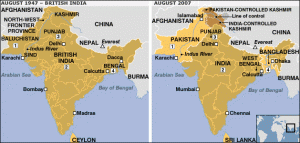By taking sides in the political divide in Ukraine, the West has sent the country of 46 million hurtling towards fragmentation. This is deeply ironic because the Ukrainian capital Kiev – where the medieval state of Kievan Rus’ was based – is acknowledged as their historic homeland by the Slavs of Russia, Ukraine and Belarus.
But this divide and conquer policy is nothing new for the West. Colonial Britain perfected the art of splitting countries and creating fault lines for the benefit of empire. When a shell-shocked Britain retired hurt after WW II, its imperial role was usurped by the United States, which has since intervened in dozens of countries.
The American role in Ukraine, where they have armed a bunch of street thugs and neo-Nazis to hold an entire country hostage, has an uncanny parallel to Britain’s role in the partition of India in 1947.
In Ukraine a small – but vocal and violent – mob comprising ultra-nationalists and opportunists, backed and armed by Americans, has conducted a successful coup against a democratically elected government. Similarly, in pre-independence India it was a small number of Muslims – carefully picked by the British – who voted for Pakistan.
 The British role in India’s division is best summed up by free India’s first interior minister Sardar Patel. He said on August 9, 1945: “The British talk of Hindu-Muslim quarrels, but who has thrust the burden on their shoulders? Give me just a week’s rule over Britain; I will create such disagreements that England, Wales and Scotland will fight one another forever.”
The British role in India’s division is best summed up by free India’s first interior minister Sardar Patel. He said on August 9, 1945: “The British talk of Hindu-Muslim quarrels, but who has thrust the burden on their shoulders? Give me just a week’s rule over Britain; I will create such disagreements that England, Wales and Scotland will fight one another forever.”
One of the little known facts about India’s partition and the creation of Pakistan is that very few Indian Muslims voted for a separate homeland. In 1947, Muslims comprised around 95 million of India’s population of 320 million. The Muslims who lived in the areas that are part of today’s Pakistan and Bangladesh initially did not want a separate country. Being the majority (around 55 per cent) in these areas they hardly felt threatened by the Hindus, and rejected the separatist Muslim League. The vast majority of Muslims voted for M.K. Gandhi’s pro-independence Congress party.
Less than 500,000 Muslims from the landowning and intellectual elites voted for the Muslim League. The Muslim elites feared an independent – and democratic – India would end their feudal privileges and hereditary titles, and introduce land reforms. The British played up these fears and showed them a way out: demand a separate homeland and Britain would broker a deal. The feudal lords of West Punjab could run the new country as they pleased; the only condition was Pakistan should ally with the West in containing the Soviet Union.
Red factor
The fear of Russia and the desire to contain it was a big factor in Britain’s decision to divide India. Those fears were magnified when the Reds took over Russia.
But it was the scenario of getting caught in a pincer between Russian Reds and another set of Reds in India that gave the British nightmares. These new Reds were the Khudai Khidmatgars (Servants of God) from the Pathan areas of northwest India.
Founded by the ascetic and gentle Badshah Khan, they were the opposite of the machismo flaunting stereotype of the average Pathan. Badshah Khan – also known as the Frontier Gandhi – made them give up weapons and follow the path of non-violence at all costs.
Known as Red Shirts because of their red uniforms, these volunteers quickly moved to the frontlines of the Indian freedom movement and demanded a speedy end to the hated British rule.
Tahir Mehdi writes in the Pakistani newspaper Dawn: “The Bolshevik revolution of Russia in 1917 was emerging as a huge challenge for imperialism. It had a natural affinity with the nations oppressed by the British. The Russian revolution was colored red. The sight of a Red Shirt in the Peshawar valley gave the British a fright.”
In 1930 at Qisa Khani Bazar in present day Pakhtunkwa, the British conducted one of their many massacres in India. “Frenzied British forces fired directly at a protest rally of unarmed Khudai Khidmatgars killing many hundreds. The movement and its committed cadre did not budge. They stood fast. Many estimate that at its peak there were as many as a hundred thousand Red Shirts.”
Finding it impossible to crack the Red Shirts, the British decided to hold elections, hoping to cool down Pathan anger. But here’s what happened. Led by Badshah Khan, the Pathans allied with Gandhi’s Congress and formed a majority government in Pakhtunkwa.
Mehdi says that despite the vociferous anti-India and anti-Hindu campaign by the Muslim League it could not ignite fears of Hindu domination among the Pathans. Pakhtun Muslims simply did not see Pakhtun Hindus as threat to their religion or politics.
Badshah Khan was completely against the idea of dividing India along religious lines. His biggest frustration was the geographical isolation of Pakhtunkwa from the Indian heartland, forcing the Pathans to become part of Pakistan. His parting words to his idol Gandhi were: “You have thrown us to the wolves.”
Lust for power
The United States has for long dreamt of getting a toehold in Ukraine in its relentless quest to become the pre-eminent power in the Eurasian landmass – that extends from Lisbon in the west to Vladivostok in the east.
Washington’s geopolitical handbook is “The Grand Chessboard: American Primacy and its Geostrategic Imperatives“. In this hate-filled tome, former US National Security Adviser Zbigniew Brzezinski says by creating instability in every country in Russia’s neighbourhood, especially in the Central Asian stans and Ukraine, and disrupting the flow of oil and gas, the US can isolate Russia, so that Moscow ceases to be a great power.
Brzezinski, a Pole, openly espouses provoking instability by exploiting the ethnic and religious diversity of the region. The grand idea was to create an “Arc of Instability” extending from Afghanistan to the stans in the southern part of the former Soviet Union.
The creation of Pakistan was key to this outcome. Pakistan was used as military outpost for covert U-2 spy flights over the Soviet Union. It became a staging post for baiting the bear in Afghanistan in the hope that Moscow would make a reckless move. Brzezinski has publicly taken credit for drawing Russia into the disastrous Afghanistan war.
With Russia’s southern underbelly in turmoil, the West’s military pact with Pakistan is now past its use by date. The Great Game now rolls west.














Pingback: CoE’s Report on Ukraine! | YERELCE
Pingback: Divide and conquer: West replays old partition game in Ukraine (II) | Oriental Review
Pingback: Divide and conquer: West replays old partition game in Ukraine (I) By Rakesh KRISHNAN SIMHA (India) | Investigating the New Imperialism
Pingback: EU freezes misappropriated Ukrainian state funds!! | YERELCE
This is the perfect site for anyone who hopes to understand this topic.
You understand a whole lot its almost hard to argue with you (not
that I really will need to…HaHa). You certainly put a brand new spin on a subject which has been written about for a long time.
Excellent stuff, just great!